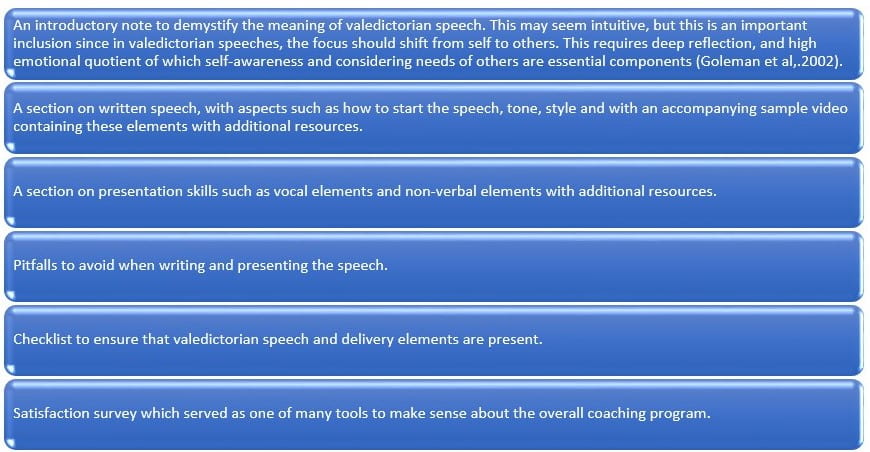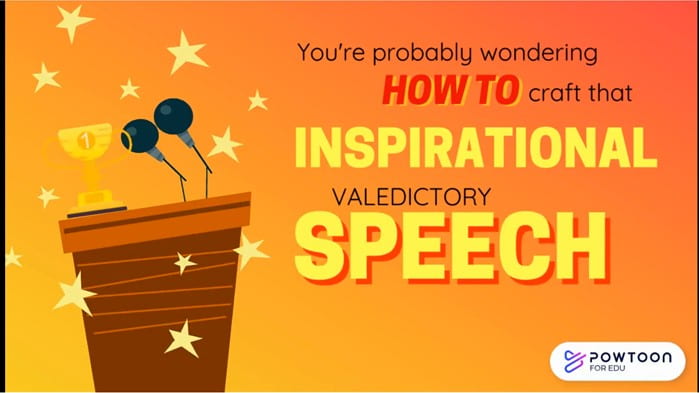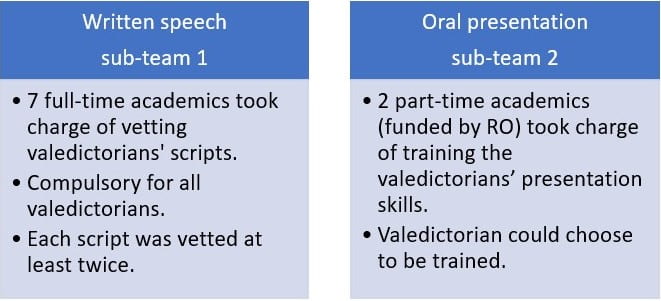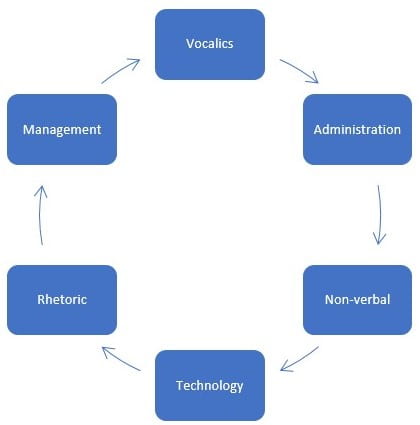Chitra SABAPATHY
Centre for English Language Communication (CELC)
When the university’s Commencement ceremonies moved to the virtual sphere
due to the pandemic, it directly impacted the speech coaching programme for valedictorians.
Chitra takes us through the strategies her training team adopted to support the valedictorians in preparing their speeches.

Sabapathy, C. (2021, Sept 29). Validating valedictorian speeches: Opportunities and challenges in a pandemic. Teaching Connections. https://blog.nus.edu.sg/teachingconnections/2021/09/29/validating-valedictorian-speeches/.
Introduction
Figure 1. In this video, the author discusses the circumstances which led to the valedictorian coaching team finding alternative ways to support the valedictorians in their speech preparations.
The online pivot made an impact on the CELC valedictorian coaching team which was interlaced with unprecedented challenges and uncertainties. At the same time, the team saw valuable opportunities which would not have been ordinarily realised. This post is an attempt at sense-making (Trowler,2020) of what it is like to validate valedictorians’ speeches in a pandemic using three strategies, termed as PAT (Planning ahead, Agile mindset, Trust and teamwork).
Planning Ahead
Before the pandemic occurred, the team developed six sets of new resources (Figure 2) to suit a fully online training mode. These resources were uploaded to LumiNUS with 24/7 access to prospective valedictorians, and departments across the university involved in the ceremony.

To capture the valedictorians’ interest, we utilised PowToon to convert Resources #1 to #3 to short videos with links to additional notes and sections (see Figure 3 for a screenshot of one of the e-resources).

Planning ahead also involved different types of evaluation to gauge the merit or worth of the programme. These included:
- Involving stakeholders in evaluative practices (as advocated by Patton, 1997), in the form of making effort, ahead of the training programme, to involve the team in designing the feedback survey. Involving other stakeholders like the Registrar Office (RO) and the valedictorians would have enhanced the outcomes of the evaluative lens; however, this could not be realised due to administrative and time constraints.
- Encouraging ad-hoc discussions to check if the practices and processes were attuned to the team’s aims and objectives.
Although these plans were useful, the process towards achieving them was complex, challenging and time-consuming.
Agility
Combining the ceremonies meant coaching almost triple (74 graduands) the traditional number of valedictorians by the standards of a traditional in-person commencement ceremony. This excluded time-consuming communications among the team members and stakeholders such as the valedictorians, departments, and RO.
Although the team was uncertain about the training mode as the pandemic unfolded in April 2020, institutional policies and measures equipped the team with an agile mindset and members were prepared to spontaneously respond to changes in timescales, training schedules, training hours, modes of training, number of valedictorians to be trained and to make the best out of the volatile situation. The newly created online resources came in handy, but the team also had to think out of the box to train the valedictorians without compromising on standards and quality. With a tight timescale, and with an increased number of valedictorians, training plans were designed as shown in Figure 4.

The agility of the part-time academics who swiftly responded to a call to assist in the training program is commendable and their participation and contributions enhanced the overall training package. Positive comments were made about both the teams’ painstaking efforts as shown in the Table 1.
Table 1
Positive comments about the coaching programme

Trust and Teamwork
Although the training team comprised full-time and part-time academics with diverse talents and expertise (Figure 5), this organically contributed to its dynamics and vigour. Trust and teamwork skills among team members as well as the trust that was bestowed on the team from the macro to micro structures in the university were instrumental in the team’s performance and offerings to the commencement ceremony. To boost trust and team efforts across various stakeholders, the team used Google Docs as a one-stop open access source to inform stakeholders on the status of the training, details on administrative staff in charge of valedictorian, and departments of valedictorians.

Feedback and Areas of Improvement
From the evaluative feedback that was voluntarily and anonymously gathered from slightly less than half the participants (n=34), the team discerned that the prepared resources and services were generally well-received and highly utilised. This was aptly summed up by one (among others) valedictorian, who was impressed with the “organised training curriculum”.
On areas to improve, most of the comments were centred on requiring more time to prepare and practice. However, since the hours were stipulated, this was logistically not feasible. The complexity of organising such a large-scale event implied multi-level communications that transpired within, across, and among various sections, departments, and stakeholders, which can cause miscommunication and confusion. To enhance future efforts, these are areas that can be improved.
On hindsight, from a coordinator’s perspective, it took time and effort to manage contradictory timescales and multi-hued expectations. Typically, it would have been easy not to see the forest for the trees. However, what worked for the team was its PAT strategies, which ensured that the team remained buoyant and was able to support the valedictorians in their commencement journey.
Acknowledgements
The author expresses her thanks to Assoc Prof Wu Siew Mei and Ms Lee Gek Ling for their guidance and advice, and to the valedictorian training team for their valuable contributions.
 |
Chitra SABAPATHY is an experienced Professional and Business Communication lecturer with CELC, NUS. She has vast experience teaching communication skills to local, foreign students and non-academic professionals. She is a strong proponent of student-centred learning and believes in meaningful teaching and learning practices. Her current interests are centered on higher education research, evaluation, and enhancement. Chitra can be contacted at elccs@nus.edu.sg. |
References
Goleman, D., Boyatzis, R., & McKee, A. (2002). Primal Leadership: Realizing the Power of Emotional Intelligence. Boston, MA: Harvard Business School Press.
NUS President’s message on Commencement (2021, May 21). NUS News. https://news.nus.edu.sg/nus-presidents-message-on-commencement/
Patton, M. Q. (1997). Toward distinguishing empowerment evaluation and placing it in a larger context. Evaluation Practice, 18(2), 147-163. https://doi.org/10.1016/S0886-1633(97)90019-2
Trowler, P. (2020). Accomplishing change in teaching and learning regimes: Higher education and the practice sensibility. Oxford: Oxford University Press.

